Or – “Comic Time, See What’s Become Of Me…”
My recent ruminations on Franklin Richards and Marvel Time have led me to think about some comics stories that have suffered from the passage of “comics time.” Many characters are somewhat tied to certain time-frames (Superman’s 30s carnival strongman uniform is one example, while Iron Man was forged in the fires of the Vietnam War) but continuity can be a harsh mistress. When Bruce Wayne (first appearance: 1939) and the Hall Brothers (first appearance: 1967) meet up in the Reagan-era, the timescales require a sliderule and an abacus to keep track of…
 THE BRAVE AND THE BOLD #181
THE BRAVE AND THE BOLD #181
Script: Alan Brennert
Pencils: Jim Aparo
Inks: Jim Aparo
Colors: Adrienne Roy
Letters: Jim Aparo
Publisher: DC Comics
Cover Price: 60 Cents (Current Near-Mint Price:$6.00)
Previously, on The Brave and The Bold: Hank and Don Hall came at least partially from the fertile mind of Steve Ditko, one of the original architects of the Marvel Universe, in his post-Marvel run at DC Comics. Created in 1968, at the height of the Vietnam War, the peace movement, and a time of great political upheaval, Hawk and Dove were a product of their times. Hawk was hot-headed, prone to violence, but lacked restraint, while Dove was thoughtful and measured, but slow to act. The boys’ adventures ran only a few issues (though Ditko left very early in the run) and later appeared as members of the Teen Titans. Remember that part, as it becomes important later… Hawk and Dove were among the many DC characters who pretty much vanished off the face of the earth after a few appearances (see also The Creeper, the Secret Six, Ultra the Multi-Alien, and half a dozen other characters from the swingin’ sixties period of expansion at DC.) In the 70’s and 80’s, MIA characters showed up in one of three places: Backups in Action Comics, summer crossovers with the JLA, or in the pages of Brave and The Bold. We open with a fun, chummy little scene as Bruce “Batman” Wayne, Barry “Shoulda Stayed Dead” Allen and Hal “Not Yet A Massive Prick” Jordan enjoy a little bonding time after an untold adventure together…
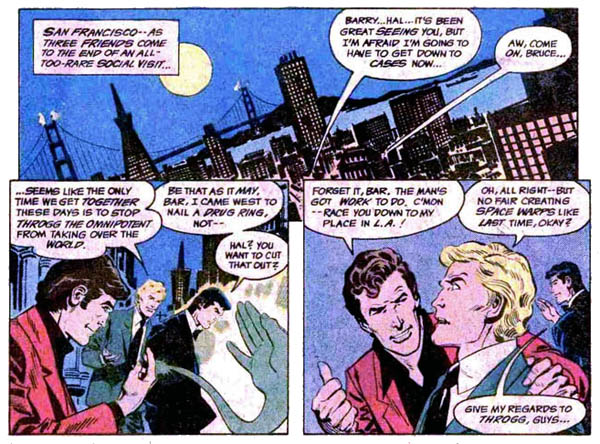 It’s hard for me to read old stories without pointing out why they were better (I am old, after all) but once again, it’s nice to see Bruce Wayne acting like a real person with his friends. Even better that his mission as Batman keeps him from going out to play without turning him into a crime-fighting machine, a caped John Henry outracing the drill of evil… or however that sentence began. Tracking the bad guy to ground, Batman is surprised by the appearance of a second avian-themed vigilante…
It’s hard for me to read old stories without pointing out why they were better (I am old, after all) but once again, it’s nice to see Bruce Wayne acting like a real person with his friends. Even better that his mission as Batman keeps him from going out to play without turning him into a crime-fighting machine, a caped John Henry outracing the drill of evil… or however that sentence began. Tracking the bad guy to ground, Batman is surprised by the appearance of a second avian-themed vigilante…
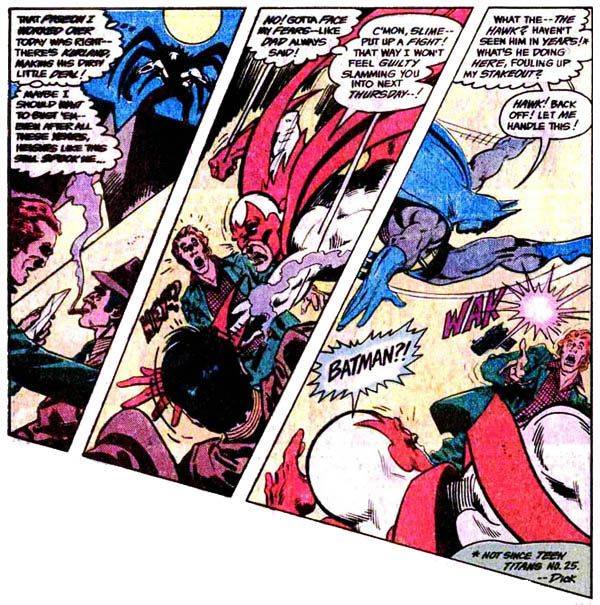 Hawk’s headstrong antics cause Batman’s prey to try and escape, leading to a fatal fall form the rooftops. Batman’s general dislike of amateurs on his turf is completely justified in this case, as not only does Hawk screw up the case and cause a man to tumble to his doom, he doesn’t even have enough concentration to keep from reverting to his non-costumed form.
Hawk’s headstrong antics cause Batman’s prey to try and escape, leading to a fatal fall form the rooftops. Batman’s general dislike of amateurs on his turf is completely justified in this case, as not only does Hawk screw up the case and cause a man to tumble to his doom, he doesn’t even have enough concentration to keep from reverting to his non-costumed form.
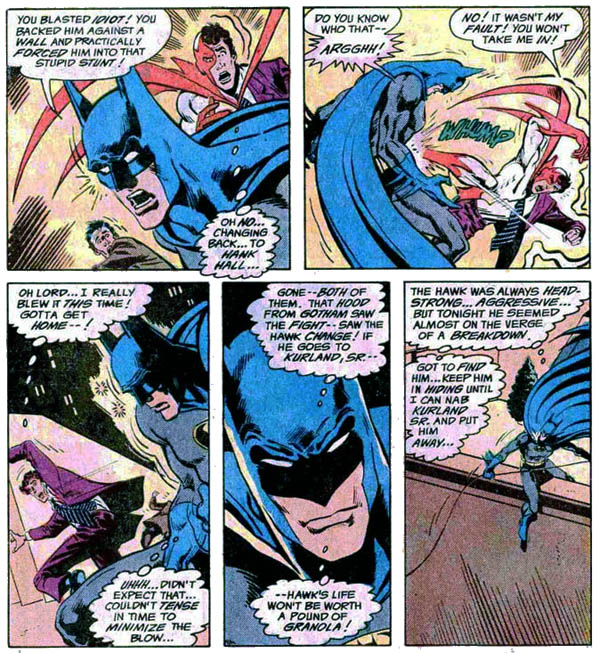 Across town, we find that things are tough all over, as brother Don Hall gets laid off from his job at the Welfare office, and gets mocked for his superhero name when trying to save innocents from a mugging. Alan Brennert is a highly underrated member of DC’s 70’s writing staff, but he’s in high form here, as Dove remembers why he and his brother have their noms de guerre (“Hawk” and “Dove” were emblematic of whether or not you supported the war) and recounts their origin.
Across town, we find that things are tough all over, as brother Don Hall gets laid off from his job at the Welfare office, and gets mocked for his superhero name when trying to save innocents from a mugging. Alan Brennert is a highly underrated member of DC’s 70’s writing staff, but he’s in high form here, as Dove remembers why he and his brother have their noms de guerre (“Hawk” and “Dove” were emblematic of whether or not you supported the war) and recounts their origin.
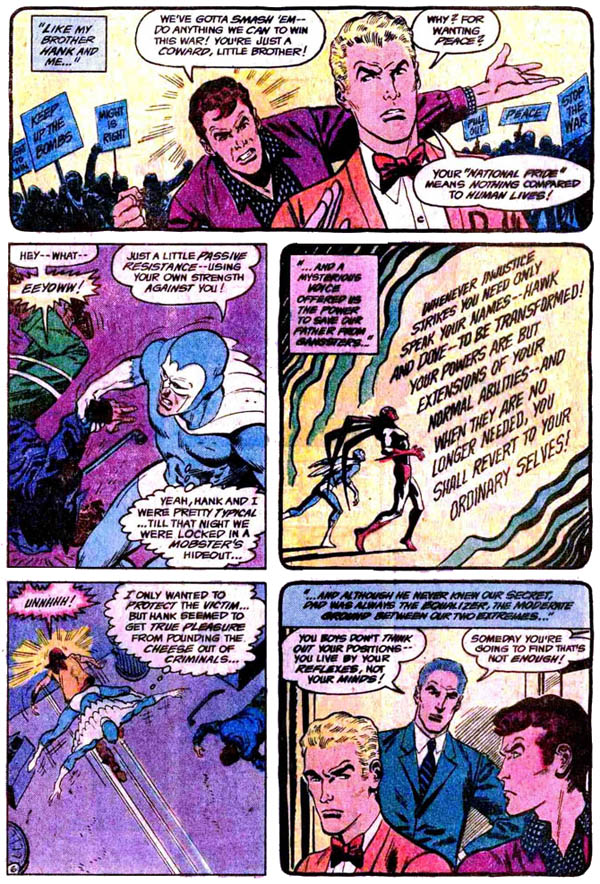 What can anybody say about the work of the late Jim Aparo other than “astonishing?” Amazing? Spectacular? Friendly Neighborhood? (Maybe not that last one…) Aparo draws what I consider to be the quintessential Batman, but more awesomely, he does the flashbacks in the in inimitable style of Steve Ditko (especially Don’s face in that final panel.) Don returns home and gets a lecture from his girlfriend about being 27 and nothing, making him wonder if he’s really nothing without his brother to balance him. Hank’s situation isn’t any better…
What can anybody say about the work of the late Jim Aparo other than “astonishing?” Amazing? Spectacular? Friendly Neighborhood? (Maybe not that last one…) Aparo draws what I consider to be the quintessential Batman, but more awesomely, he does the flashbacks in the in inimitable style of Steve Ditko (especially Don’s face in that final panel.) Don returns home and gets a lecture from his girlfriend about being 27 and nothing, making him wonder if he’s really nothing without his brother to balance him. Hank’s situation isn’t any better…
 That’s not the worst of it for Hawk, though. The gang lord whose son he accidentally killed is searching for the Hawk, determined to kill the hero in revenge. Batman manages to track down the Dove through superior detective work (“First rule for aspiring super-heroes, Don. Get an unlisted number.” Heh…) and Batman and Dove follow the trail to the out-of-control Hawk. After flipping out and threatening to injure and innocent woman, Hawk got shanghaied by Kurland’s goons. The worst part of his day is yet to come, though.
That’s not the worst of it for Hawk, though. The gang lord whose son he accidentally killed is searching for the Hawk, determined to kill the hero in revenge. Batman manages to track down the Dove through superior detective work (“First rule for aspiring super-heroes, Don. Get an unlisted number.” Heh…) and Batman and Dove follow the trail to the out-of-control Hawk. After flipping out and threatening to injure and innocent woman, Hawk got shanghaied by Kurland’s goons. The worst part of his day is yet to come, though.
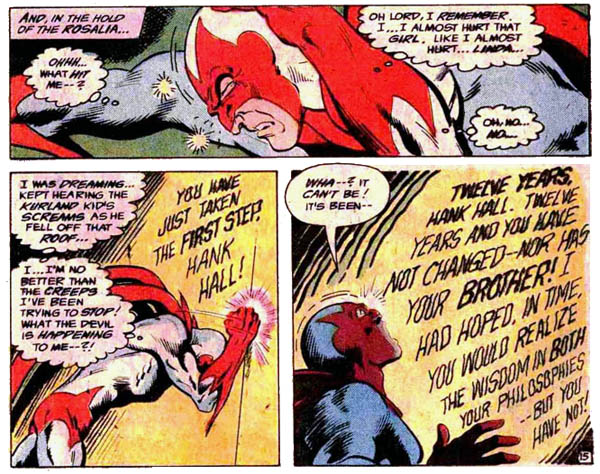 The Voice which gave the brothers their powers returns, chiding him for not learning from his time with powers. (The voice also goes out of its way to tell him that it is NOT the Capital-G-Man in the sky he had always thought it was.) The voice tells Hawk that the experiment is over, fading away with the last thought that, someday, if he fulfills his human potential, his power may return…
The Voice which gave the brothers their powers returns, chiding him for not learning from his time with powers. (The voice also goes out of its way to tell him that it is NOT the Capital-G-Man in the sky he had always thought it was.) The voice tells Hawk that the experiment is over, fading away with the last thought that, someday, if he fulfills his human potential, his power may return…
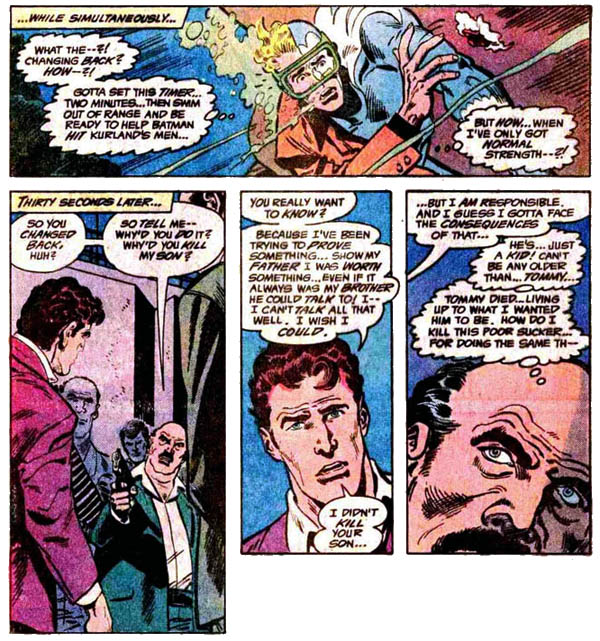 Batman and Don arrive to save Hank, and a reversal occurs as Hank stands silently in consideration while Don leaps into two-fisted action, decking crooks left and right. Both brothers, now powerless, realize that perhaps they HAVE learned from one another, and Batman delivers the moral of the story.
Batman and Don arrive to save Hank, and a reversal occurs as Hank stands silently in consideration while Don leaps into two-fisted action, decking crooks left and right. Both brothers, now powerless, realize that perhaps they HAVE learned from one another, and Batman delivers the moral of the story.
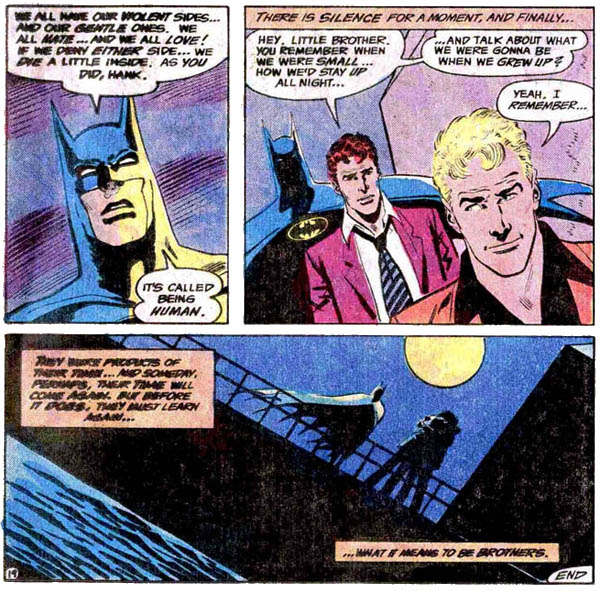 It’s a lovely tale, and it ably manages to capture the Me Decade’s split-screen reversal of and reverence for the principles of the 60’s. If you’ve ever seen the Big Chill (or indeed pretty much any movie from the early to mid 80’s) you know what I’m talking about. Brennert delivers character without falling prey to pathos or excessive melodrama, while Aparo delivers a wonderful art job throughout. But, if you’ve been paying attention, you can obviously see the problem with this issue. By aging Hawk and Dove in real-time (making them nearly thirty in this story), you’ve made them roughly the same age as the then-eternally-29-year-old Batman. Batman, whose junior partner/ward Robin is roughly 8 to 10 years younger than him, probably 18 or 19 at this writing. Robin, who led the Teen Titans from the beginning. You with me on this one? If Hawk and Dove are 27, then the Teen Titans are 27, which should push Batman into his mid-40s, and now we’re cha-cha-ing. This story also explains a throwaway joke in the sublime Tales of the Teen Titans #50, the wedding of Donna Troy…
It’s a lovely tale, and it ably manages to capture the Me Decade’s split-screen reversal of and reverence for the principles of the 60’s. If you’ve ever seen the Big Chill (or indeed pretty much any movie from the early to mid 80’s) you know what I’m talking about. Brennert delivers character without falling prey to pathos or excessive melodrama, while Aparo delivers a wonderful art job throughout. But, if you’ve been paying attention, you can obviously see the problem with this issue. By aging Hawk and Dove in real-time (making them nearly thirty in this story), you’ve made them roughly the same age as the then-eternally-29-year-old Batman. Batman, whose junior partner/ward Robin is roughly 8 to 10 years younger than him, probably 18 or 19 at this writing. Robin, who led the Teen Titans from the beginning. You with me on this one? If Hawk and Dove are 27, then the Teen Titans are 27, which should push Batman into his mid-40s, and now we’re cha-cha-ing. This story also explains a throwaway joke in the sublime Tales of the Teen Titans #50, the wedding of Donna Troy…
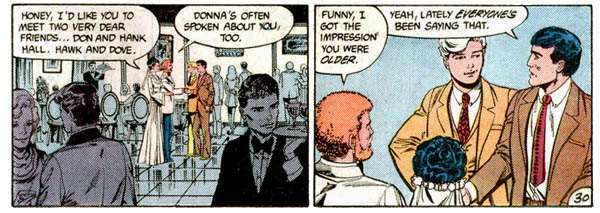 This sort of thing used to happen pretty often, back in the day, especially in The Brave & The Bold, most notably while written by Bob Haney. Haney also created and wrote the wonderfully goofy “Super-Sons” saga in World’s Finest Comics, wherein Superman & Batman had teenage sons in a contemporary timeframe, in complete ignorance of the frozen time-state in which they all live. Haney never let continuity stand in the way of telling an exciting tale, and this issue lives up to that legacy. It’s a great disappointment that my internal continuity cop chatters like a monkey all the way through great stories like this, worrying and nattering about nothing. Fact is, this is a wonderful issue, and a great capstone to the careers of The Hawk and The Dove as they existed circa 1981, meaning that Brave and the Bold #181 earns an awesomely-drawn and skillfully-written 4 out of 5 stars overall.
This sort of thing used to happen pretty often, back in the day, especially in The Brave & The Bold, most notably while written by Bob Haney. Haney also created and wrote the wonderfully goofy “Super-Sons” saga in World’s Finest Comics, wherein Superman & Batman had teenage sons in a contemporary timeframe, in complete ignorance of the frozen time-state in which they all live. Haney never let continuity stand in the way of telling an exciting tale, and this issue lives up to that legacy. It’s a great disappointment that my internal continuity cop chatters like a monkey all the way through great stories like this, worrying and nattering about nothing. Fact is, this is a wonderful issue, and a great capstone to the careers of The Hawk and The Dove as they existed circa 1981, meaning that Brave and the Bold #181 earns an awesomely-drawn and skillfully-written 4 out of 5 stars overall.
Faithful Spoilerite Question Of The Day: Why in the world does continuity seem to matter so much?



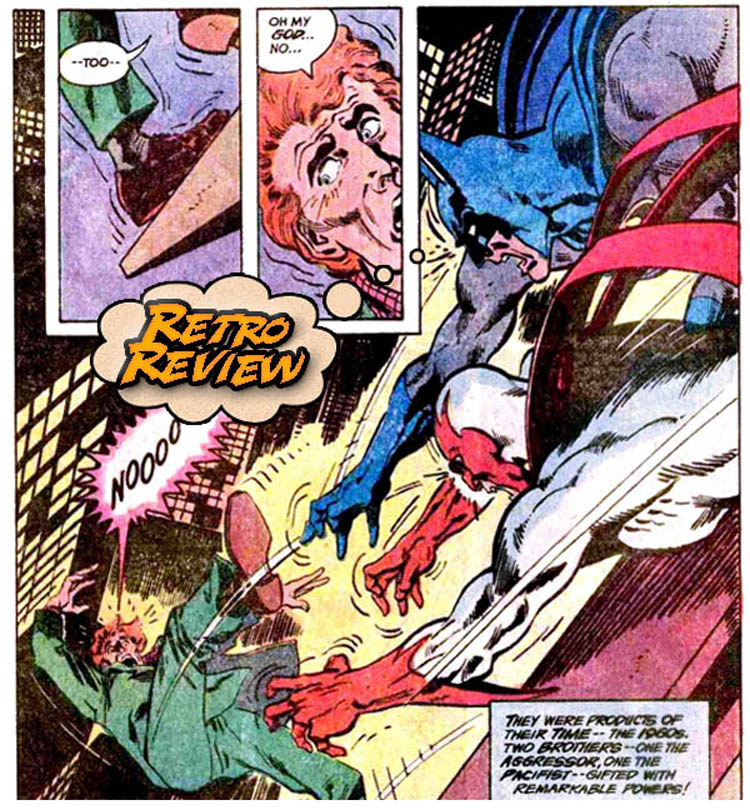
12 Comments
Continuity is important because it allows for richer, more meaningful story-telling. If every issue, or every arc, was a complete stand-alone story that didn’t apply to what happened before or what happened next, there would be no weight to the story, nor would there be any importance.
Continuity gives context. Sometimes we can have too much of it, but we need to know, in order for us to truly care for these characters, that their actions are going to have consequences.
Sometimes we can get mired down. There are definitely times I wish all the comics at Marvel and all the comics at DC weren’t so strongly linked. Because, as much as I hate reboots, sometimes they are needed. But you can’t tell the final Amazing Spider-Man story and re-launch the character next Spring because, well, what would the Avengers do? What would the FF do? How would this “new” Spider-Man relate to all the other characters who already know and love and hate him?
But I’m pro-continuity. I love seeing the shadow of the villain we haven’t seen in ten years, recognizing it, and remembering what (s)he did last time (s)he tormented our hero and HOLY CRAP WHAT WILL HAPPEN NEXT?!
But perhaps we could be lighter on the continuity. Maybe it’s not as important as we like to think it is.
I think the problem isn’t if your pro or anti continuity; it’s that people don’t realize we can have both. I call it the “My idea is more important that yours” syndrome. Batman, Superman, Spider-Man, Captain America and many other popular heroes have multiple titles. Why do they all have to share the same continuity? It wouldn’t be as confusing as you think if you label it properly. They already do it to a certain extent.
I’ll say this. I’d be more accepting of the new Spider-Man status quo if it wasn’t for OMD and OMIT which I consider to be Joe Quesada flipping the bird to my side of the fanbase and telling us how much better his Peter Parker is than the one we liked.
At Grant Morrison’s panel at comic con last year (I think the podcast is still on the DC website) he answered the continuity issue and every other similar question by saying: It’s a comic book! Now I usually hate that answer, Michael Dorn is fond of saying something similar, but he goes on to make a good point.
We could all be reading For Whom the Bell Tolls, or Crime and Punishment, and we’d get enough literalism and objective truth to make us cut our wrists, but we’ve chosen comic books. We have all chosen to read about superpowers, magic, monsters and gods, and then we have the nerve to say, well that could never happen.
Batman is, was and ever shall be awesome. If you want to watch someone age in real time watch Regis Philben. But if you want to be part of the whole Batman thing a certain amount of suspension of disbelief is necessary, especially when you’re dealing with limitations that are inherent in the format.
And I’m going to be a total flaming doosh here and point out that I think the word you were looking for is bathos. Pathos is when you successfully pull at the heart strings and bathos is schmaltz.
Yeah, i know, i know, but these things bug me.
Bathos? Pathos? Where the hell is Aramis?
Scott Bakula is feeding him cheese.
It matters because you can’t insult the intelligence of the reader. When you have someone that follows a story, they don’t want to have something pop up that throws off the flow of the story or the reader’s impression of the character(s).
Thank you for this one, Matthew. Brave and the Bold was one of the first titles I discovered after I jumped ship from being a Marvel-Only reader to a DC-Curious reader with the New Teen Titans. Jim Aparo’s Batman will always be my favorite Batman. This title introduced me to so many great characters I had not seen anywhere else: The Creeper, Metamorpho, The Spectre, Swamp Thing, and Hawk & Dove. I have this issue and remember it fondly.
There were a lot of memorable stories from that era. Questionable continuity was par for the course. They never made a point that the Spectre and Batman were from different earths at that time. If you go way back, they did the same with Wildcat appearances.
A few more team ups that were memorable were with Earth-2 Robin and Huntress. Both were outstanding stories.
…turning him into a crime-fighting machine, a caped John Henry outracing the drill of evil… may be the funniest thing you’ve ever written…
As for continuity (especially in shared universe serialized fiction), it’s a fine line between ignoring key elements that came before making those tales mean less and a slavish devotion to the projected ages of tertiary characters who appear once in a blue moon. It’s the slavish devotion to continuity that ultimately soured me on Marvel and DC’s superhero universes.
…turning him into a crime-fighting machine, a caped John Henry outracing the drill of evil… may be the funniest thing you’ve ever written…
Why thank you, sir… Although I think that the exploding squirrels of Omicron 12 might argue differently.
I’m pro-continuity but what happened to that sense of fun and almost blind acceptance readers used to have where one would just enjoy a story (regardless of where it ‘fit’) and let it stand on its own merits?
I blame the fans (the “everything has to be explained” ones and especially some older fans, who simply don’t want to admit they’re too old and should have gotten out of the “sandbox” years ago and let others play).
This story is/was an example of being such a good tale – screw the frakking continuity!
That Aparo art makes me nostalgic. He was an amazing artist.
For years, he and Neal Adams were my entire world.
I started reading comics in the early 60’s – mostly Batman and Superman, and there was NO continuity in those days. In fact, every story had to reset by the end of the comic. So, yes, Batman could go back in time and be a caveman, and Superman could split into red and blue versions of himself, but you knew that no matter how outright stupid the story was, it would never have happened when you picked up the next issue. It was an eye opener when a friend let me borrow a stack of early Spiderman comics. Suddenly there was continuity and continuing storylines, too. DC jumped on the bandwagon soon after, and introduced continuity to their books. But only within their books. There would be one story arc and continuity in Detective comics, a completely different story and continuity in Batman, and the same with Action and Superman comics. But this did lead to strange things like Superman being missing in action on some alternate dimension in one book while he is making television apperances in the other book at the same time, or Robin being away in college in one book while at the same time he is swinging on a rope with Brucey boy in the other at the same time. I actually preferred those days compared to today where you have to buy each of the 16 separate Batman titles plus four or five cross-overs forced into DC’s least popular titles in order to get the whole story. Marvel fell into the same trap, putting key parts of Spiderman stories into the Batroc the Leaper Summer Fun Issue or some such damn thing hoping to force Spiderman fans to buy some piece of garbage they normally wouldn’t even blow their noses on. I like continuity better than no continuity. The 70s were great for comics, with both companies moving away from the sixties silliness, giving their characters a more realistic edge, and with much better artists, applying their own styles to the art instead of trying to ape the art styles that had smothered the characters for decades before. One thing I do like better today is the death of exposition. I recently reread the classic Teens Titans “Terra” saga which was earth-shattering in its day, but it doesn’t hold up today – mostly because right in the middle of the combat, with the fate of multiple universes hanging by a single tread, Nightwing whips out his latest toy and spends three or four panels explaining what it is, what it does, what it is made of, where to order one of your own, recapping the last six or seven issues, and going on and why he no longer wants to be Robin without really telling you why he thinks Bruce is such a jerk, etc., while the evil doer politely stands by waiting for him to finish, rather than pulling an Indiana Jones on him and blowing him while he’s busy showing off. And, getting back to the point, it’s very likely that DC thought nobody would notice that Hawk and Dove were the wrong age because they hadn’t been used for about ten years at the time, and in those days DC thought that only kids bought comics, so there shouldn’t have been many readers who remembered them. Comic books aren’t the only thing that have problems with time. Consider the newspaper strip “Gasoline Alley” which has allowed their characters to age but kept them around so long that the main characters would now be about 120 years old! Blondie and Dagwood would be ninety. Little Orphan Annie aged from five to twelve years old in fifty years, but in real years she’d now be ninety or so. Maybe the answer is to let Batman or Superman have kids and hand off the job to a new generation in about twenty years, but then you get into the problem of the new characters not having the same motivation as the previous generation. Instead, nowadays, the comic book companies cheat by “rebooting” the universe every ten years or so. And let’s not even get into the mess caused by having the characters die (but not really) over and over again. Sigh. Of course, if comics were more like real life, then they wouldn’t be very good escapist literature, now, wouldn’t they?